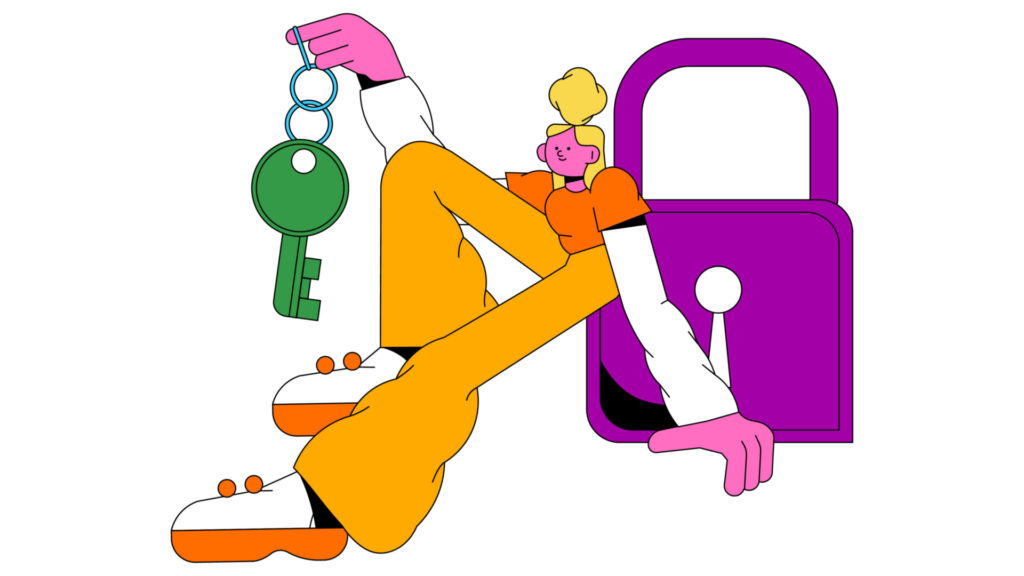Anyone who has spent time and money developing an online course knows that Intellectual Property (IP) is of the utmost importance. It’s what distinguishes your course from all the others out there, and protects your investment.
In this blog post, we will look at 7 ways you can practically protect the IP of your online course material.
But before we do, let’s look at what defines intellectual property within the context of online course material and why it’s important to protect.
What is intellectual property and why does it matter for course creators?
First things first, anything you produce with your intellect, such as a story, artwork, product, or course, is considered intellectual property. Just like any other type of property, with your written permission, intellectual property can be bought, sold, and owned by multiple people. Unfortunately, this also means it can be stolen.
In the context of your online course and all other related online content, your intellectual property may include:
- Your course content
- Your videos and online resources
- The names of your products or brands
- The design or look of your products
It helps to compare similarities between traditional property and intellectual property. Physical, real assets like a car, a computer, a home, and property are examples of traditional property. When people discuss property ownership, these tangible assets often spring to mind as it’s a lot easier to comprehend ownership over something that you can touch, hold and build on.
Intellectual property is obviously set apart in this fact. These are intangible assets that hold value, yet they can’t materialise into physical assets. While this may sound as though they do not hold as much worth, in most cases, IP holds a much greater value than most tangible assets one may acquire.
Why is it important to protect intellectual property online?
These days, few course creators and edutainers have a brick-and-mortar business with products that you can touch and hold.
Instead, if you’re an education-based business creating products like courses online, the value of your business is going to lie almost entirely in the intellectual property assets within your profitable online courses.
This implies that your media material and course content must have prioritised protection in place. Simply put, as a course creator if it’s worth developing your own content, it’s worth protecting.
If you don’t secure your intellectual property in the very first days of starting your course building, you risk losing the money, the time, and the resources you have invested to build your brand and entire online course curricula.
Types of intellectual property
When you’re learning about intellectual property online, it’s critical to understand the many ways you may safeguard your IP and what you need to do to guarantee that your business is safe.
First up, there are two key types of intellectual property: copyright assets and trademark assets.
Copyright assets
Copyright is a form of law that helps protect your creative works. If you have a course or course curriculum, you can protect this using copyright.
Under copyright law, the copyright for a creation belongs to the creator.
For entrepreneurs, this is important because copyright law covers any creative work done for your business. That means, if you outsource the design of your brand logo to a graphic designer, they are the automatic copyright owner of your logo.
If you’re running a business and outsourcing tasks, it’s important to make sure that you have the rights to any assets that are produced for your business. To do this, you need to get a formal agreement expressed in writing that confirms that the owner of the copyright transfers the rights to you.
The same principle applies to photographers, blog writers, and any other content creators – if someone is producing assets for your business, you need to make sure that you have the copyright for those assets.
Copyright is shown using the © symbol.
On your website, you can include a copyright notice to flag that you own the rights to the content. This should include the copyright symbol or the word ‘copyright’, the year you release the content, and the name of your business.
It is worth noting that you do not in fact have to use the © symbol in order to claim copyright. You still have rights in your content, even if you don’t use the symbol.
Trademark assets
Technically speaking, a trademark is a source identifier for consumers to relate back to where a service or product comes from.
There are four different types of trademarks:
- A word or name
- A phrase or slogan
- A symbol or a logo
- A sound like a tune, saying, or jingle
When you start selling any of these assets for a profit, your trademarks take effect.
For creators, that means that as soon as you start using your brand name and logo when selling your course content, you start officially using your trademark.
If your brand name is just in your head or you’re using it for your social media or domain name, you don’t have the rights to it. It needs to be used commercially for it to count as a trademark.
The trademark symbols are ™ and ®.
The difference between copyright and trademark assets
Simply put, a trademark is an identifier for a product – think about it as the label on what is being sold. A trademark is the name of your company, the name of your brand, your slogan or tagline, and even your logo.
The copyright is the content – any photos, online course videos, audio content, written content, emails, and more.
Now, let’s look at 7 ways that you can protect your intellectual property.
1. Make your copyright clear
As we’ve previously mentioned within copyright assets, you should consider the inclusion of a copyright symbol (©) or disclaimer on your content. Although it doesn’t offer extra protection for your intellectual property, it can make people think twice before they reproduce or share your content.
A copyright symbol shows people that your content belongs to you and flags up that they could be in trouble if they try to reproduce it.
Sometimes that is all that is required in order to keep your online IP safe while deterring others from producing online courses with your stolen content.
2. Watermark your content
One of the most practical ways to protect your intellectual property online, add your name, logo, and/or website URL in a watermark to your training videos and documents. This will stop a lot of theft immediately, as it is rather hard for others to pass your material off as their own if your branding is all over it.
In any case, if your content still manages to be shared illegally, it has your logo, face, and website. It’s still you who will get the credit, fans, and business that may arise from someone watching your content.
3. Print & mail content to yourself
This is a way of both physicalising and timestamping your IP. Simply print out your whole course, including the curriculum plan, lesson plans, and content; then mail it to yourself as tracked and recorded delivery, then never ever open it.
If other online course creators ever reproduced your content and it went to court for dispute, you have the dated evidence of when your content was created and how long it has been around for.
This is a simple, yet effective way of having indisputable evidence around who has property rights.
4. Time stamp your content
When it comes to online content, don’t overlook the fact that if you’re putting it up publicly, it indicates that you published it first.
Fortunately, today’s technology is big on date logging all material. This means every blog post, YouTube video, social media post, and live stream video shows the original post date. If a replica piece of content comes out after yours was published, it’s obvious who got it from who.
So, don’t be afraid to share your material. Getting your content online soon, rather than later is to your own benefit.
5. Show your face
One of the easiest ways to bring clarity to who was behind a piece of content is to personify your lessons.
This means, do not just simply write everything but shoot content in a ‘talking head’ video format. A ‘talking head’ is exactly what it sounds like, meaning your face will be on screen delivering the content itself.
With all the earlier points around dates and timestamps, having yourself deliver the material on camera becomes an airtight case for who the true owner is.
6. Keep an eye out for duplicates of your content
Use free online tools at your disposal, such as Google Alerts. This completely free Google tool allows you to enter various search terms, such as your name and certain terminology and phrases that your content may regularly use.
When you set up a Google Alerts account, you will be notified via email whenever those terms or phrases are published online, allowing you to check them out and see whether you’ve been plagiarised, properly cited, or if it’s purely coincidental.
Remember, you are covering the same topic as those who may have similar content, so it isn’t the craziest thing if you find some similarities. Each case requires some discernment.
You may also use plagiarism detectors to see whether your work has been copied elsewhere. There are several options available., but one of them is Copyscape, where you can insert the URL to your blog post for example, and it will then scan the web for matching content.
7. Use in-built flagging tools on YouTube
If someone has used your material without permission on YouTube, there is a procedure for reporting the copyright infringement right away. Fill in the webform available through YouTube Studio to submit a takedown request.
If your claim is determined to be valid, you may be entitled to the ad revenue generated by the material, which will return money to you – a major benefit for protecting your intellectual property on the web!
Summary
If you want to profit from your work, whether it’s instructional videos, downloadable material, photographs, or anything else, you’ll need to know how to safeguard your intellectual property online. Protecting your intellectual property is critical because it will help you generate money for your business.
Copyright is a complex issue, but it’s important to make sure your content is protected. Watermarking, timestamping, and using other methods can help you keep track of where your content is being used and how it’s being shared.
If you’re ever concerned about duplicate content or someone using your work without permission, don’t hesitate to reach out to the Archy team.
With a little bit of effort, you can protect your hard work and ensure that you get the credit (and the traffic) you deserve.
Have you tried any of these techniques? Let us know in the comments below!





1 thought on “7 ways to protect the IP of your online course”
Copyright is tricky! thanks for the tips